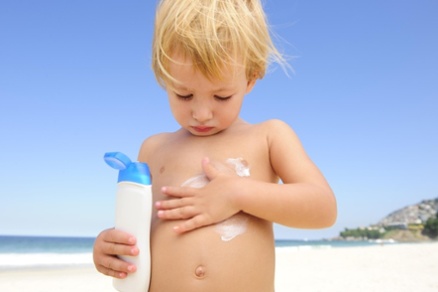The risk of skin cancer can be increases by a small number of serious sunburns. Don’t underestimate the power of the sun’s rays and the impact it can have on your child’s skin. The good news: there are plenty of ways to keep your children safe in the sun without compromising the summer fun! Read on for our quick tips and recommendations about children and sunscreen.
Children under six months should not wear sunscreen, therefore it’s important to keep them in the shade when outdoors. The hours of 10 a.m. – 2 p.m. are peak hours for UV rays, and are often the hottest hours of a summer day. It’s best to avoid outdoor activity with your infant during this time. If they are outdoors, dress them in sun-protective clothing, like darker colors, tightly-woven fabric, and keep them dry; a wet t-shirt offers less UV protection. Use a wide brimmed hat for their heads and they’re good to go!

Children over six months should also avoid direct sunlight during those peak hours we mentioned previously. Activities in the shade can be just as fun during the summer. Hats and sun-protective clothing are also good options, keeping in mind you don’t want them to overheat. When applying sunscreen, they should be wearing SPF 30+. Our favorite brands are Blue Lizard Baby and Neutrogena Baby.
Sunscreen Basics
- Each year when summer rolls around, it’s easy to reach for last year’s sunscreen, but don’t! Sunscreen expires, and like many products, decreases in effectiveness and can even become more harmful when expired.
- For the best protection, sunscreen should be applied 30 minutes before heading outside, and should be reapplied throughout the day, especially after swimming or exercise.
- When choosing a sunscreen, inorganic filters like zinc oxide or titanium dioxide will minimize the potential burn if it gets in your child’s eyes.
Don’t Be Fooled!
- Cool and cloudy days do not mean the risk of sunburn and UV damage to your skin decreases. Clouds don’t block the harmful UV rays, they only slightly filter them.
- If you are noticing your child is turning pink-ish while outside, a burn is likely on its way and will show up within 12 hours. A sunburn won’t show up right away, but prolonged sun exposure will only make it worse when it does arrive.
If you have questions or concerns about sun safety, skin cancer, or how to pick the right sunscreen, get in touch with our expert team! Your skin’s health is our top priority.


Leave a Reply